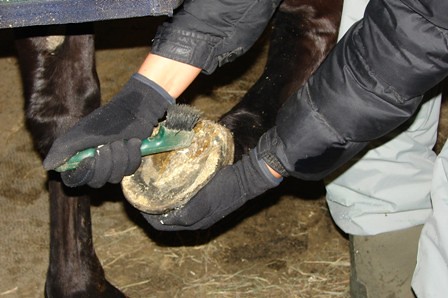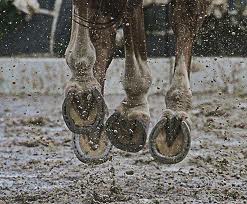Stable Management – White Line Disease

![]() photo credit: eXtensionHorses
photo credit: eXtensionHorses
White line disease can be a fatal blow to your horse. As the old saying goes, “no hoof, no horse”. We’ve all heard it and it is an important fact of life for a horse. They need to be on their feet at a moments notice to run, flee and skedaddle.
Horses don’t often get sick but because of the way that their bodies work, and the fact that they spend most, if not all of their lives standing, and don’t usually lie down for lengths of time their hooves are very important.
Hoof Care

Hoof care is important. Without proper care they would not be able to withstand the normal wear and tear of performance or recreational riding. Some of the most familiar horse diseases have to do with the horse’s hooves.
- Thrush
- Navicular
- Sidebone
- White Line Disease
What is White Line Disease?
White line disease attacks the part of the hoof wall attaches to the hoof structure – the white line. When bacteria gets into the white line structure (laminae) it destroys the holding ability and the hoof wall becomes detached from the hoof structure. The destructive bacteria that causes white line disease is an anaerobic bacteria that thrives without oxygen. So keeping your horses hooves clean and kept in a dry area is a good preventative measure.
The bacteria then travels up the sensitive laminae causing these structures to become crumbly and soft. The outside of the hoof wall becomes dry and brittle and may also become cracked.
The disease of the white line should be treated immediately to prevent further deterioration and further crumbling of the horse’s hoof. If not treated the white line disease will continue to soften the hoof structure and could cause considerable pain.
How Horses Get White Line Disease
Prevention of white line disease is better than a cure. Follow these tips to prevent white line disease:

- Pick your horse’s feet regularly
- Keep horses in a dry area to prevent moisture in their feet
- Have your horse’s hooves trimmed regularly
- Treat horse immediately if hoof disease is suspected.
White Line Disease Treatment
If you suspect white line disease contact your farrier and determine the best course of action. One such course could be paring the hoof back until solid wall is found and treating the hoof with antibiotics. Other treatments may include soaking the hoof in coppersulphate for 20 minutes to kill any bacteria or fungi that is present.
It is important to have your farrier and vet assist in the diagnosis and treatment.
 Try these three powerful exercises to get strengthen your position.
Try these three powerful exercises to get strengthen your position.

One thought on “Stable Management – White Line Disease”
Comments are closed.